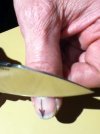The thinner blades of kitchen knives without a lot of belly is a good place to start because they are the easiest knives to sharpen, and you should have some early success.
Beginners have a tendency to get hung up on what angle they are sharpening at which is a waste of time and energy at this point. In good light lay the blade on the stone at a low angle and tilt it up until you see
the apex displace water and make contact with the stone and then lock the wrist, it's really irrelevant what the angle is, you are not training to hold a particular angle just a consistent one.
If the blade has a belly the elbow raises with the curve of the blade, it's not in the wrist.
Beginners have a tendency to get hung up on what angle they are sharpening at which is a waste of time and energy at this point. In good light lay the blade on the stone at a low angle and tilt it up until you see
the apex displace water and make contact with the stone and then lock the wrist, it's really irrelevant what the angle is, you are not training to hold a particular angle just a consistent one.
If the blade has a belly the elbow raises with the curve of the blade, it's not in the wrist.

